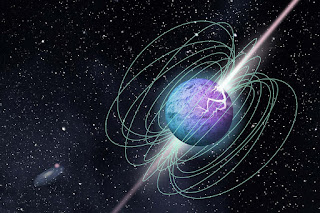Fast Radio Bursts (FRBs)
In radio astronomy, a fast radio burst
(FRB), also known as a Lorimer Burst, is a transient radio pulse that lasts
about a fraction of a millisecond. It is
one of the oddest puzzles of modern astronomy.
FRBs are rare, extremely bright flashed of light with radio wavelengths. They put out more energy in one millisecond
than the Sun puts out in 3 days. FRBs
are named by the date that the signal was recorded as “FRB YYMMDD”. In most cases, the high frequency signal
shows up first, followed by the low frequency signal. This is known as dispersion. It was estimated that 10,000 bursts a day was
occurring and that 1,000 FRBs arrive at Earth each day.
Astronomers were unsure how FRBs were
generated. Theories included supernova
activity, colliding neutron stars, or neutron stars falling into black holes,
or comets and asteroids slamming into neutron stars, or primordial black holes
exploding. There was even a theory that
they were lighthouse beams created by aliens.
In 2007 Duncan Lorimer of West Virginia
University and his student, David Narkevic, detected the first FRB (FRB 010724). They were using the Parkes 64-meter radio
dish in Australia and were looking through archival pulsar (rapidly rotating
neutron stars) survey data when they discovered the first FRB. The archived data was first detected by the
Parkes Observatory on July 24, 2001. The
FRB (5 millisecond burst) was located near the Small Magellanic Cloud.
In 2012, FRB 121102 was discovered as
one of three repeating sources. It was
identified with a galaxy 3 billion light-years away. The FRB was located in the direction of the
constellation Auriga using the Arecibo radio telescope (300 meter dish) in
Puerto Rico. Arecibo later detected 10
more FRBs.
In 2013, four more FRBS were detected
(FRB 110220, FRB 110627, FB 110703, and FRB 120127).
On January 19, 2015, the first FRB was
observed for the first time live, by the Parkes Observatory.
In 2015, FRB 110523 was discovered in
archival data collected in 2011 from the Green Bank Telescope in Green Bank,
West Virginia. It was the first FRB for
which liner polarization was detected.
In 2015, three studies supported the
hypothesis that FRBs were related to hyperflares of magnetars (ultra magnetized
neutron stars).
In 2016, the Very Large Array (VLA) in
New Mexico started hunting FRBs.
In 2017, the Molonglo Observatory
Synthesis Telescope (UTMOST) near Canberra, Australia, detected 3 FRBs.
In September 2017, the Canadian Hydrogen
Intensity Mapping Experiment (CHIME) radio telescope came online in British
Columbia. It was used to detect hundreds
of FRBs. It detected 13 FRBs will still
being tested.
In 2018, three FRBs were reported by the
Parkes Observatory. One (FRB 180309) had
the highest signal to noise ration yet seen at 411.
In October 2018, 19 FRBs were detected
by the Australian Square Kilometre Array Pathfinder (ASKAP) radio telescope.
On January 9, 2019, a second repeating
FRB (FRB 180814) was discovered by CHIME.
In January 2019, FRB 180924 was
identified as a non-repeating FRB from a galaxy nearly the size of the Milky
Way.
In June 2019, Russian astronomers discovered
9 FRBs. FRB 151125 was the third
repeating one ever detected.
In August 2019, eight more repeating FRBs
were detected by CHIME.
In January 2020, a repeating FRB 180916
was detected with precise location in the medium-sized spiral galaxy SDSS
J015800.28+654253.0 about 500 million light-years away. It was the closest FRB discovered to date and
the first FRB to have regular periodicity.
In March 2020, CHIME found 10 more repeating
FRBs.
The FRB origins seems outside our Milky
Way Galaxy. They seem to come from
regions with strong magnetic fields. The
discovery was made by Dongzi Li, an astrophysicist at the University of
Toronto, using the Canadian Hydrogen Intensity Mapping Experiment (CHIME) radio
telescope in British Columbia. [source: “Periodic activity from a
fast radio burst source,” arXiv.org, Jan 28, 2020]
On
April 28, 2020, a pair of millisecond bursts came from FRB 200428, in the same
area of the sky as the magnetar neutron star SGR 1935+2154 inside the Milky Way
galaxy. It was the most powerful FRB yet
observed and the first detected in the Milky Way galaxy. The FRB was detected by CHIME. The neutron star is about 30,000 light-years
away in the constellation Vulpecula. SGR
1935 had 200 X-ray bursts in 20 minutes the day before. The next day it emitted another flare. Newly ejected electrons and particles
collided with debris from the previous flare which may have produced the FRB.
In
April 2021, astronomers detected a new, nearby, repeating FRB, originating from
a spot near the M81 spiral galaxy, 12 million light-years away. The FRB repeated its burst in January 2020,
July 2020, and November 2020. This may
be the closest FRB found so far.
[source: earthsky.org, April 8, 2021]





Comments
Post a Comment